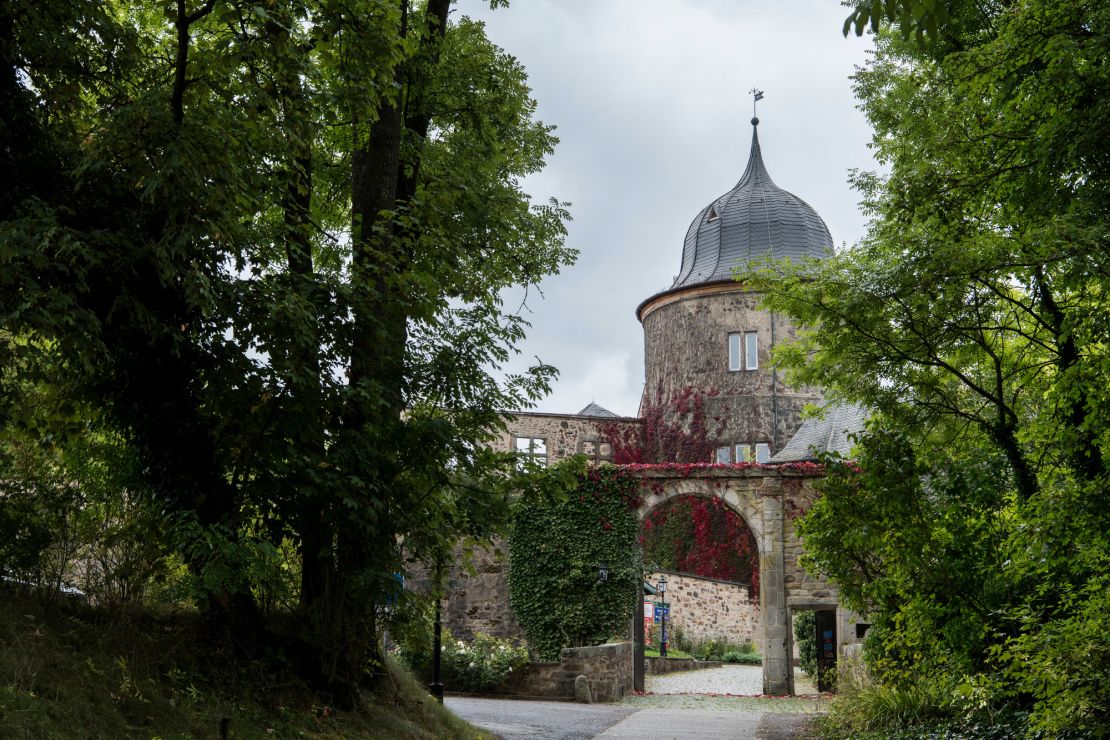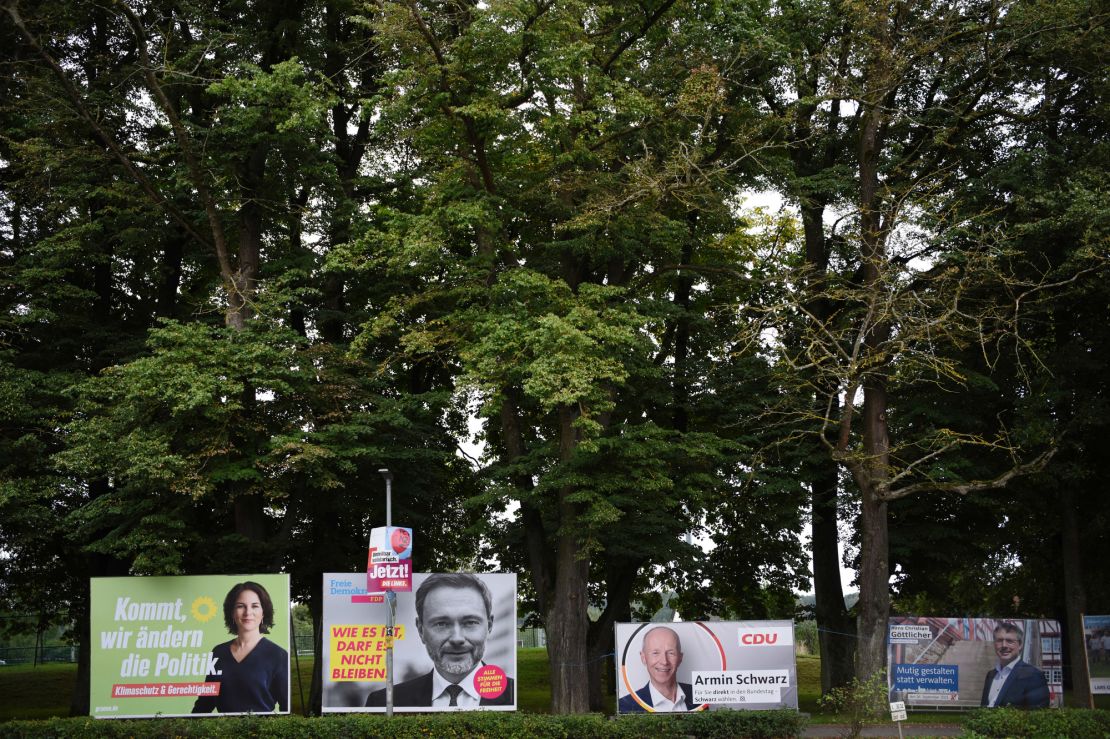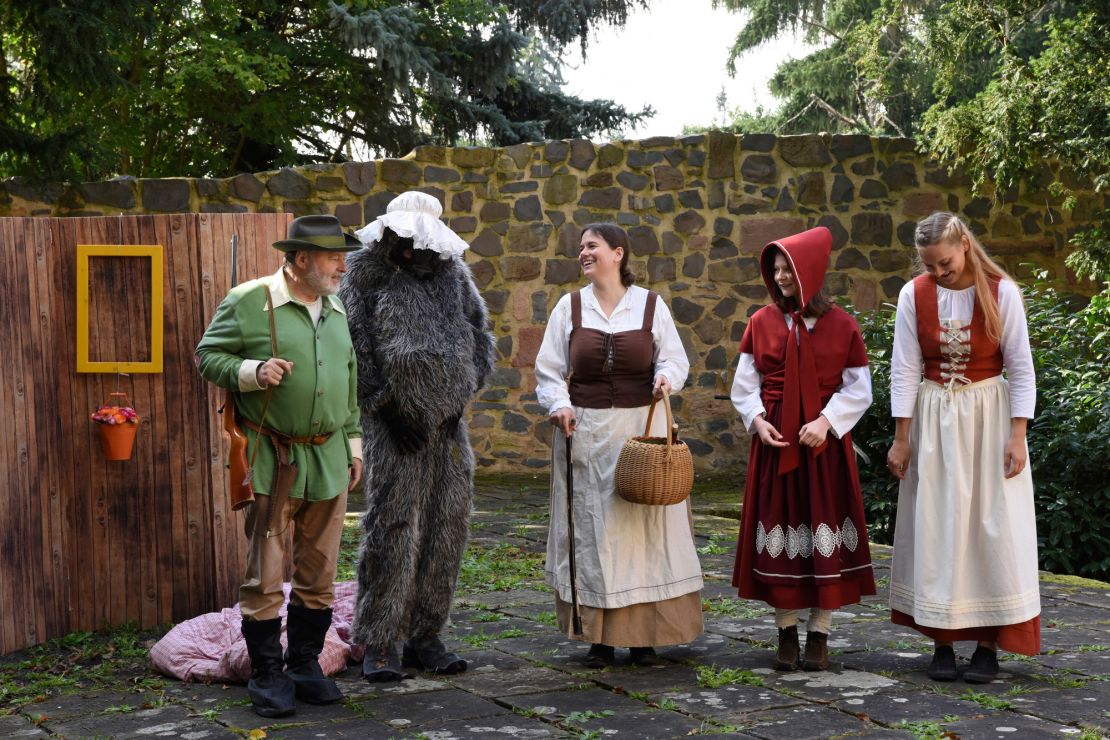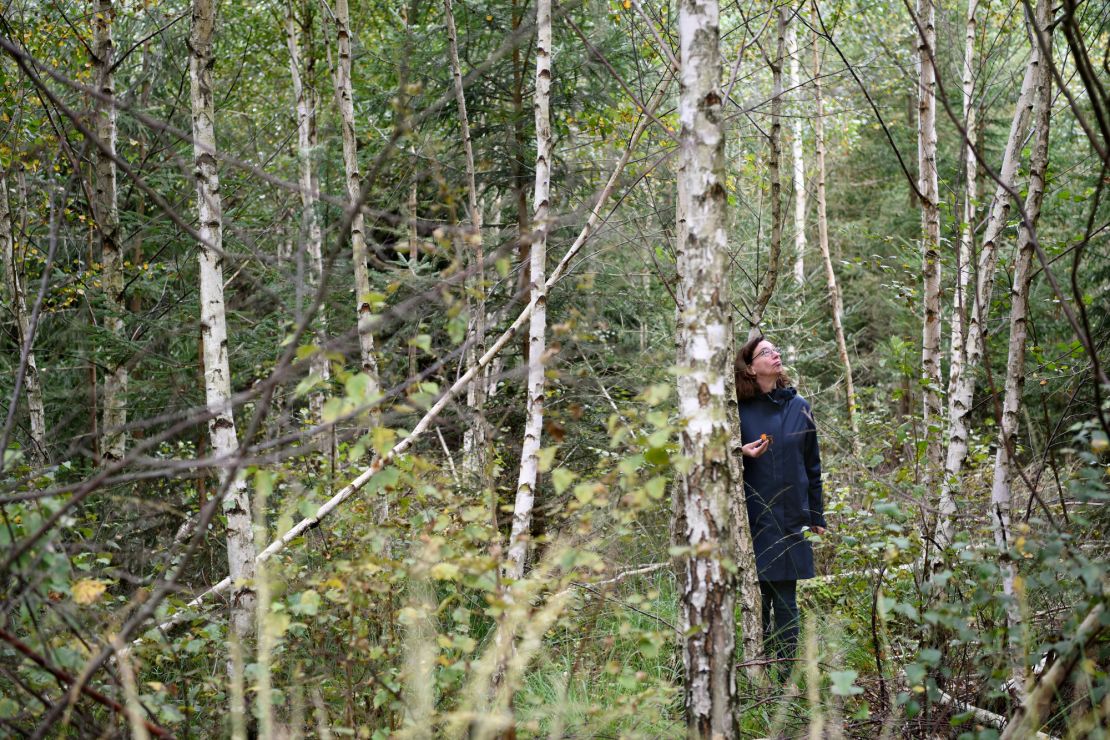Gazing out from the rocky ledge of Sleeping Beauty’s castle in central Germany, the countryside below stretches out in a patchwork of light and dark green forests before stopping dead.
At the heart of this lush landscape sits a swath of dry, bare earth. The ground is empty, save for a few ghostly white trunks pointing skywards.
Viewed up close, this scene in the Reinhardswald nature park is equally desolate. Brittle sticks crunch underfoot and tree stumps dot the empty landscape, which stretches over some 50 acres.
The spruce trees that once stood here have been killed by a bark beetle infestation. The insects thrive in the warmer and drier weather conditions that occur more frequently because of climate change.
“Once the bark has peeled off, the trees look a bit like bones,” said Peter Meyer, head of forest nature conservation at the North-West German Forest Research Institute in Göttingen and Hann Münden.
Bark beetle infestations are worsened by drought conditions, since once the tree has been weakened by a lack of water, it can’t produce enough resin to combat the insects.
“Then the beetle can just drill into the tree, lay eggs underneath the bark, and the larvae feed on the tree, interrupting the water supply, and that makes the tree die,” Meyer explains. “Drought is the trigger for bark beetle infestations.”
Germany has suffered historic drought in recent years and 2018 was the warmest since records began 140 years ago. In other parts of the country this summer, rain has fallen hard and fast, triggering deadly floods.
All of these events have put the climate crisis squarely on the campaign trail ahead of Germany’s federal election on Sunday. It’s the first in 16 years that won’t feature Chancellor Angela Merkel, and the candidates vying to replace her are all pitching their climate credentials.
The crisis is being felt in many parts of Germany, and the country’s fairy tale forests are no exception.

Germany’s climate election
Rose bushes cling to the ancient walls of the 14th century Sababurg Castle, said to have inspired the Grimm Brothers’ fairy tale “Sleeping Beauty.”
On a chilly September morning, a steady stream of tourists is visiting. Their route here is lined with towering piles of logs – all that remains of the Reinhardswald’s damaged trees, cut down to halt the beetles’ spread.
The winding road is dotted, too, with electoral posters; the grinning faces of political candidates adorn lampposts and road signs, marking a national election in which green issues have taken center stage.
Germany’s next chancellor will face a hefty list of climate challenges as they steer Europe’s largest economy toward its goal of carbon neutrality by 2045, including the transition from fossil fuels to renewables; replacing combustion-engine cars with electric ones; and the completion of the controversial Nord Stream 2 pipeline, which brings gas from Russia to Germany under the Baltic Sea.

The election comes just months after devastating floods in western Germany submerged entire towns and killed more than 180 people. At the other weather extreme, Germans suffered two years of extreme drought in 2018 and 2019 and watched as large parts of southern Europe were wrecked by wildfires this summer.
Scientists have warned for decades that climate change will make extreme weather events more frequent and intense, but this summer’s floods created a fresh sense of urgency, prompting environment minister Svenja Schulze to declare that: “Climate Change has arrived in Germany.”
All these events have led many to wonder how Germany will meet its emissions-reduction goals. The country has pledged a 65% cut in emissions by 2030, compared to 1990 levels. There are also questions over whether Germany is doing its fair share to meet the Paris Agreement’s target of limiting global warming to well below 2 degrees Celsius.
Germany is off track in achieving its emission targets. It should be at 40% below 1990 levels this year, but an increase in emissions as it recovers from the pandemic means it will miss that target.
It’s a downbeat note for Merkel, once dubbed the “Climate Chancellor,” to leave office on. While she has supported ambitious emission-slashing goals, her government had only planned to phase out coal by 2038, regarded as late for a developed nation. And funding natural gas – a climate-changing fossil fuel – through Nord Stream 2 is a sore point.
Merkel’s replacement will play a leading role in shaping Europe’s climate policy at a pivotal moment in the fight against global warming: In November, world leaders will gather in Glasgow, Scotland, for international climate talks, known as COP26.
“The approach that the next German government takes can have a major multiplier effect for European climate action, and EU climate leadership on the world stage,” said Rafael Loss, co-ordinator for Pan-European Data Projects at the European Council on Foreign Relations.
But with just days to go before the election, it is not at all clear who will be the next chancellor. Polls put the center-left Social Democrats (SPD), led Olaf Scholz, slightly ahead of Merkel’s Christian Democratic Union (CDU), led by Armin Laschet.
Whatever the result on Sunday, lengthy coalition negotiations are expected – and the Greens, led by Annalena Baerbock, are likely to be the kingmakers, polls show, meaning climate has become a key election issue in the country.
A Greens presence in government would undoubtedly force Germany’s next government to be more ambitious on climate.

A Grimm story
Baerbock’s recent political advertisement was filmed in Germany’s forests, a place of deep ecological and cultural importance to people here.
“Your voice decides on the last government that can actively influence the climate crisis before it’s too late,” Baerbock says, as a drone camera zooms high above the Harz Mountains in northern Germany – another region ravaged by the bark beetle.
Forests are among crucial solutions to the climate crisis: They suck up much of the world’s carbon and store it safely underground.
In Germany, they are the country’s green lungs. Forests cover 11.4 million acres – about a third of the country – and capture roughly 62 million tons of carbon dioxide from the atmosphere each year, according to the Ministry of Food and Agriculture.
They are also a source of wealth, providing 76 million cubic meters of timber each year, for use in everything from construction to paper manufacturing. In the last seven years the average market value for Germany’s roundwood production amounted to over 3.5 billion euros ($4.1 billion) annually.
But Germany’s forests are, by some measures, in their worst shape for decades.
More trees died in 2020 than in any other year on record, according to the government’s annual Forest Conditions Report. The study examined 10,000 trees across the country and found that just 21% had an intact canopy – an indication of how healthy a tree is – the lowest percentage since studies began 37 years ago.
“Crown condition is like a medical thermometer; it shows how the trees are doing. The survey shows: our forests are sick,” said Agriculture Minister Julia Kloeckner.
The main culprits were the bark beetles. The insects mainly attack spruces, which are the most common tree species in Germany, making up 25% of the country’s forests.
Last year, around 43.3 million cubic meters of damaged timber had to be cut down as a result of bark beetle infestation, according to the Federal Office of Statistics.
Germany’s spruce forests date back to the reforestation efforts of the 19th and 20th century, when degraded woodlands were restocked with this fast-growing tree species. Broadleaved forests were also converted to spruce forests.

Meyer estimates that this decimated patch of spruce trees in Reinhardswald Nature Park, within hiking distance of Sleeping Beauty’s castle, is around 80 years old.
To the average passer-by, the brittle landscape looks like a graveyard of skeletal tree trunks. But Meyer, who has studied trees for more than three decades, sees signs of scraggly new growth; he says if left to its own devices, the forest can heal.
A short distance from the Sleeping Beauty castle also sits the lush Sababurg Primeval Forest.
Step amid the trees here and the temperature drops away as the sunlight disappears behind a thick canopy of leaves. Towering oaks – some dating back 600 years – stretch their gnarled limbs, cloaked in a shiny jacket of green moss towards the sky.
Unlike the decimated spruce forest nearby, this woodland has been spared the devastation caused by bark beetle infestation.
Experts hope forests like this one can offer clues as to which tree species may be more resistant to rising temperatures in future. So far, they have found that “oak trees appear to be more tolerant to drought and water logging, to extremes of climate, than beech trees for example,” Meyer says.

A 21st century enchanted wood
Forests aren’t just Germany’s lungs – they are part of its cultural heart.
The country’s woods are the centuries-old backdrop to fairy tales like “Red Riding Hood,” “Snow White” and “Hansel and Gretel;” the ideal, spooky setting for encounters with mythical creatures.
The stories were collected by the Brothers Grimm in the 19th century. They have since been translated into more than 160 languages and are still read to children across the world.
The brothers’ childhood home at Steinau, in central Germany’s Hesse region, has been transformed into a museum.
On a sunny Saturday afternoon, tourists wander around the imposing building where the family lived in the 1790s. Small children squeal with delight as a storyteller dressed as a goat tap-tap-taps on a small wooden door in the pretty gardens; nearby, seven-stone dwarves stand guard by the rose bushes.

Forests feature in at least a third of the roughly 250 stories collected by the brothers, according to the museum’s curator Burkhard Kling.
One room inside the museum is dedicated entirely to forests, with dozens of tiny dioramas featuring familiar characters in woodland settings, confronting wolves or nibbling candy houses.
Kling explains why woods inspire such fear and wonder among storytellers: “It’s dark. You don’t know what is behind the next tree… You don’t know if there’s an animal that wants to catch you,” but: “When you see the light behind the trees, you can find hope.”
Germany’s fairy-tale towns
The effects of climate change are also being felt at other stops along Germany’s popular fairy tale tourist trail.
Alsfeld is known as “Red Riding Hood town,” after the traditional red caps worn by girls in the region.
This picturesque spot markets itself as a must-see for fairy tale enthusiasts, attracting some 90,000 overnight visitors each year.
Its 14th century bookshop is lined with copies of “Red Riding Hood” books in multiple languages.
Nearby, a crooked half-timbered building nearby has been transformed into a house of fairy tales, complete with Rapunzel’s long plait trailing from the third-story window. The gardens of the local church often play host to open-air performances of the Grimm Brothers’ stories.
When not playing the grandmother in one of these “Red Riding Hood” performances, Jenny Wagner works as a tour guide, thrilling visitors with tales set in the deep, dark woods. But over the last three decades she’s seen the nearby forests of her childhood change dramatically.
“When I was a young girl, we often went on hiking trips into the forest and there was a bed of leaves above you,” says Wagner. “You can hardly find that anymore. If you go into the forest, you have a lot of trees that don’t really carry any leaves.”
The forests around Alsfeld are a big draw for visitors; Mayor Stephan Paule says without these recreational spaces the town – and its economy – would suffer; an important “source of revenue for the town will disappear,” he warns.

Age-old tale
The challenges facing Germany’s forests have changed a lot in the last four decades. So too have its environmental activists.
Meyer, a softly-spoken scientist with a knack for spotting tiny apples or mushrooms hidden amid the foliage, began studying forestry in the 1980s, at a time when acid rain was killing Germany’s woods – a phenomenon known as “Waldsterben,” or forest dieback.
“It was sort of a catastrophic impression of the forests, and that we really have to act to do something,” he said.
Efforts were made to clean up the coal mines and the forests revived. But the environmental calamity left its mark on Germans, who saw the woods as part of their identity.
The “Waldsterben” of the 1980s, along with concerns over nuclear power, became central to the budding Green Party’s activism.

Decades on, Germany’s new generation of environmental activists take a broader view of the climate crisis.
“The emotional connection my parents’ generation, my grandparents’ generation, has to forest is very different to my connection,” explains Helena Marschall, a 19-year-old economics and politics student at Leuphana University, who is part of the Fridays for the Future school strikes against global warming.
Marschall says that while she is concerned about the state of German forests, “the climate crisis is fundamentally a question of my life, and not so much an abstract concept of nature.”
Merkel is the only chancellor Marshall has ever known – this will be the first national election in which she is old enough to cast her vote. She says the so-called “Climate Chancellor” hasn’t lived up to her billing, and sees this election as a chance to “build a different kind of politics.”
Just days before Germans go to the polls, the Fridays for the Future movement plans mass demonstrations across the country, with millions expected to take part.
Germany’s fairy-tale forests have survived for hundreds of years – the challenge for the next chancellor will be to ensure they are protected far into the future.






